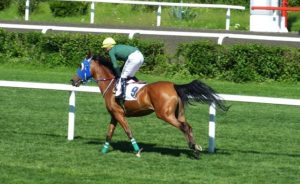Which were the three highest-rated two-year-olds of 2023, according to Timeform?
 At the time of writing, the first Classic of the season, the 2,000 Guineas on the Rowley Mile at Newmarket, which is scheduled for Saturday, May 4, 2024, is still some months away. However, as ever, the ante-post market is already well formed, so it’s high time we looked at what Timeform made of the two-year-old form in 2023.
At the time of writing, the first Classic of the season, the 2,000 Guineas on the Rowley Mile at Newmarket, which is scheduled for Saturday, May 4, 2024, is still some months away. However, as ever, the ante-post market is already well formed, so it’s high time we looked at what Timeform made of the two-year-old form in 2023.
According to the Timeform analysts, the three highest-rated two-year-olds of 2023 were City Of Troy (125p), Henry Longfellow (120p) and Vandeek (119p). However, it is worth noting that, in each case, the ‘p’ indicates that more than normal progress is likely, so the numerical ratings are by no means set in stone.
The first-named pair are both thrice-raced, both unbeaten and both trained by Aidan O’Brien, so it should come as no real surprise to learn that, at the time of writing, they dominate the ante-post market for the 2,000 Guineas. City Of Troy, who falls into the ‘high class’ ratings band, according to Timeform, is currently a top-priced even money favourite, while Henry Longfellow is merely ‘very smart’ and can be backed at 5/1, with 12/1 bar the front two.
Both Ballydoyle colts are already Group 1 winners, but, while Henry Longfellow apparently made a seamless transition to the highest level when winning the Vincent O’Brien National Stakes at the Curragh with plenty in hand, that form is open to question. He faced just three rivals on that occasion and, with his main market rival, Bucanero Fuerte, looking a non-stayer on his fist attempt over 7 furlongs, what he actually achieved remains to be seen. By contrast, City Of Troy was nearly as impressive when winning the Dewhurst Stakes as he’d been when winning the Superlative Stakes in the summer and looks a very, very solid option.
However, his current odds offer little in the way of value, so the ‘smart’ Vandeek is definitely worth a second look, for all that the jockey James Doyle, who rode the son of Havana Grey to victory in the Middle Park Stakes, described him as ‘a pure ball of speed’. Joint-trainer Simon Crisford has already said that he ‘could easily go further’, so, at 20/1 in a place for the 2,000 Guineas, it will be interesting to see which route connections take.
 Notwithstanding the change of date in 2022, made to accommodate Easter, on April 17, the Scottish Grand National, run over 3 miles, 7 furlongs and 176 yards at Ayr, is traditionally staged a week or two after the Grand National at Aintree. Consequently, few horses attempt the Aintree-Ayr double and those that do have precious little recovery time between the two races.
Notwithstanding the change of date in 2022, made to accommodate Easter, on April 17, the Scottish Grand National, run over 3 miles, 7 furlongs and 176 yards at Ayr, is traditionally staged a week or two after the Grand National at Aintree. Consequently, few horses attempt the Aintree-Ayr double and those that do have precious little recovery time between the two races.